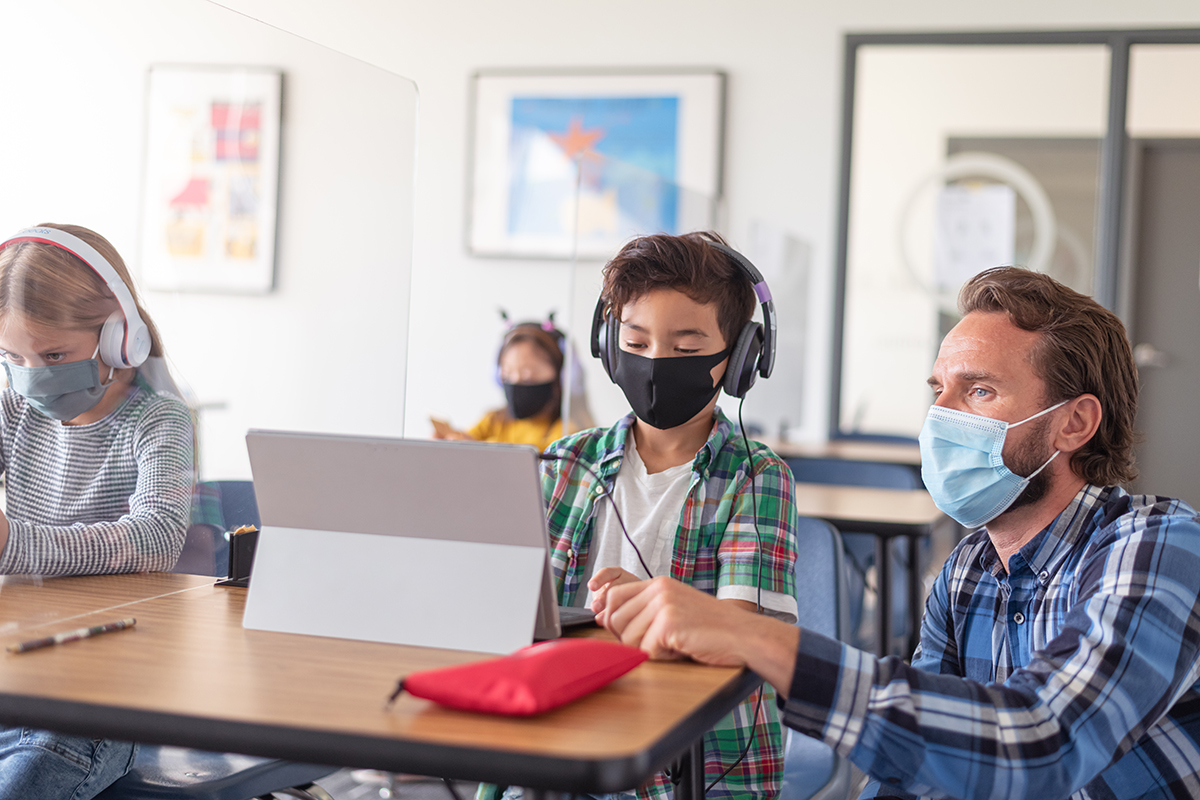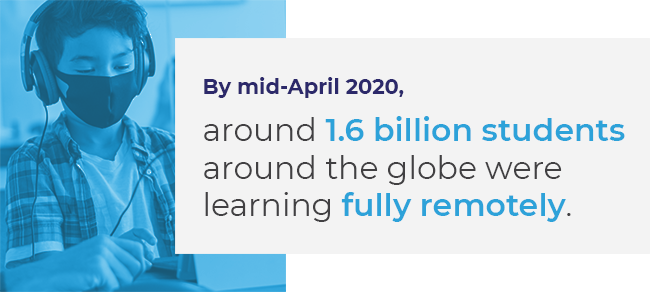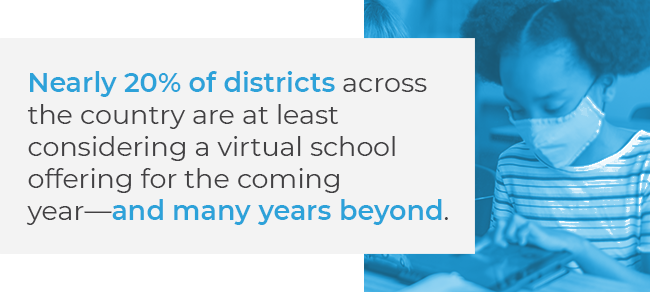September 24, 2021 8:00 am
Nine Tips for Success with Virtual Learning
Whether you are new to the virtual classroom or an experienced online teacher, here are a few tips for success with virtual learning.
Right now, schools everywhere are utilizing some amount of virtual instruction to keep students learning, regardless of educators’ comfort and experience levels with delivering instruction virtually. Whether you are new to the virtual classroom or an experienced online teacher, there are a few tips for success with virtual learning you can utilize to make this easier for you, your colleagues, and your students.
Offering targeted training and online learning resources will ultimately help students (and your school) succeed. Our nine tips for success with virtual learning are great both for educators who may be new to online learning and those who want a refresher on how to be the best teacher in their virtual classroom.

Nine Tips for Success with Virtual Learning
- Set Up Your Workspace. At this point, I think we all can agree it’s time to relocate our “office space” from the kitchen or couch! As we adapt to the “new normal” of learning, creating a quiet, comfortable workspace will help you stay organized and on track. What resources would you usually keep on hand? Is your area equipped to support you technologically? These are things you shouldn’t have to worry about while schoolwork is underway.
- Set Aside Time to Prepare for YOUR Week. Set aside time over the weekend to plan your school week. Take this time to not only focus on grading and lesson planning but also on how you can connect with students and create activities to encourage engagement. Doing this will help you sleep better and be able to start Monday off in the right frame of mind.
- Be Available for Quick Help. It’s easy to say, “I am there for my students,” but it means so much more to show up to the virtual classroom alongside your students. When you teach in person, you’re almost always available when students need that extra support. So, log in to your class a few minutes early and stay those 10 extra minutes after—provide consistent support, and your students will reap the benefits.
- Don’t Forget to Log Off. Teaching virtually doesn’t mean you need to be on call 24/7. Let your students know your hours of availability for extra help, and keep to your schedule. You need downtime now more than ever, so make sure to respect the time you spend away from the classroom.
- Encourage Students to Create Their Own At-Home Workspace. Just like a student has their desk in school, students should have that personal space for learning at home that is free from distractions. Ask students to send you a picture of their “at-home classroom” as part of your introductions to students, and share a photo of yours. Make it exciting for them to have their own space!
- Get to Know Your Students. Schedule one-on-one time with each student, even if it is just for five minutes. Students are most likely not going to make the proactive decision to get to know you or their peers; however, by cultivating a positive and fun environment, you can drive student engagement. Your number one focus every day should be connecting with students and helping them stay connected to their peers and education. Are students communicating? Are they collaborating? Are they asking questions? Are they answering questions? Just like in your physical classroom at school, you need to help facilitate connections with other students, so keep pushing them forward!
- Keep Students Interested and Engaged. Easier said than done, we know. However, if there is one thing students have lost during the pandemic, it is their independence. Give students the opportunity of choice. Creating decision-making opportunities allows students to feel in control of their education. And importantly, you are recognizing a student’s voice while also keeping them engaged and involved in activities and discussions.
- Create a Community. Group projects and class time could be the most interaction with others that a student is getting. Encourage students to not only come to you with questions and conversation but to also go to each other. Provide discussion topics to help steer conversations, and promote the community for when you are not available: outside of school hours and weekends. Let students know they always have support within their virtual classroom!
- Address Common Questions or Issues from Students. It is important to remember that there may be technical challenges or issues with students’ coursework. If you are receiving frequent complaints or questions regarding a topic or process, take the time to address the problem for the whole class. Some students won’t come forward with their questions or concerns, so plan for that by doing things like designing a how-to section or students. Providing these resources that are specific to your classroom and coursework prevents students from falling behind due to technological or directional error. And don’t be afraid to contact IT if you can’t resolve the problem—you are not expected to also be a technology expert!
Additional Resources and Tips for Success with Virtual Learning
There are so many great resources available to help teachers (and parents) engaging in virtual learning. EdWeek has published a number of helpful articles full of tips for both teachers and administrators, including the following:
- Classroom Routines Must Change. Here’s What Teaching Looks Like Under COVID-19
- Dos & Don’ts of Teaching in a COVID-19 Environment
The Inter-Agency Network for Education in Emergencies (INEE) has also launched a COVID-19 webinar series for administrators setting up their schools for 2020–2021. Hear from various international education experts as they share their tips for success with virtual learning, including how to support teachers and why you should offer SEL resources for both adults and children. Access the entire series, or watch the specific webinars that help address your learning needs.
And for more information about supporting your students and staff, check out our tools for building school reopening plans.
SOURCES
DARBY, F. (2019, APRIL 17). HOW TO BE A BETTER ONLINE TEACHER. CHRONICLE. HTTPS://WWW.CHRONICLE.COM/INTERACTIVES/ADVICE-ONLINE-TEACHING
KRAUS, C. (2020, JULY 14). EMOTIONALLY CONNECTED LEARNING IS POSSIBLE ONLINE: START WITH RELATIONSHIPS. EDSURGE. HTTPS://WWW.EDSURGE.COM/NEWS/2020-07-14-EMOTIONALLY-CONNECTED-LEARNING-IS-POSSIBLE-ONLINE-START-WITH-RELATIONSHIPS
LAMBERT, D. (2020, MAY 13). A LOOK AT DISTANCE LEARNING STRATEGIES FOR SUCCESS: EDSOURCE WEBINAR. EDSOURCE. HTTPS://EDSOURCE.ORG/2020/A-LOOK-AT-DISTANCE-LEARNING-STRATEGIES-FOR-SUCCESS-EDSOURCE-WEBINAR/631433
TATUM, J. & FAGAN, E. (2020, JULY 13). 5 WAYS TO BUILD A STRONG ACADEMIC SCAFFOLD FOR 2020-2021: PART 1. ESCHOOLNEWS. HTTPS://WWW.ESCHOOLNEWS.COM/2020/07/13/5-WAYS-TO-BUILD-A-STRONG-ACADEMIC-SCAFFOLD-FOR-2020-2021-PART-1/?ALL












